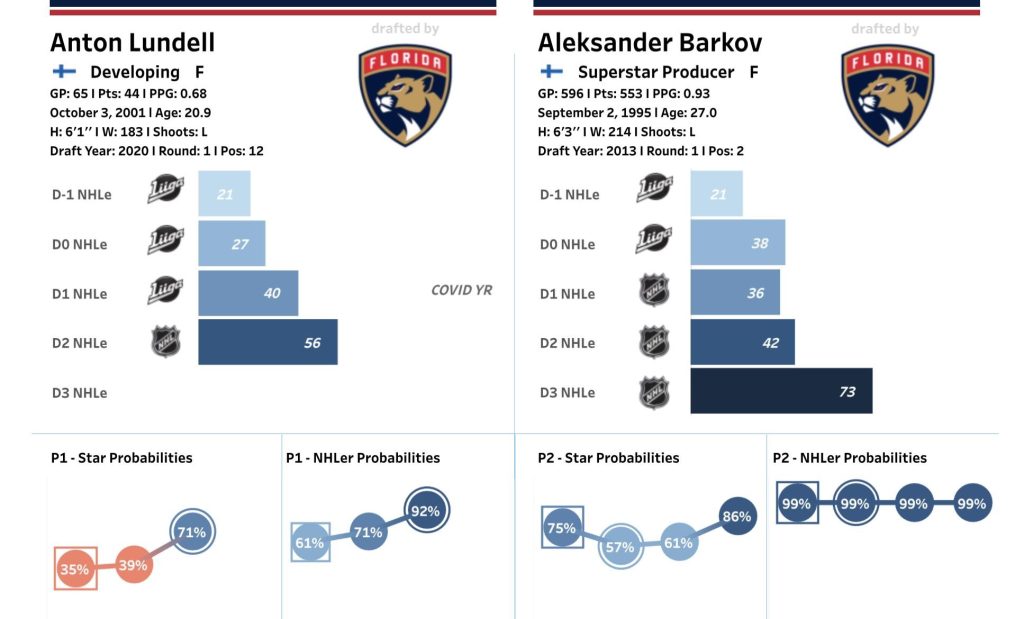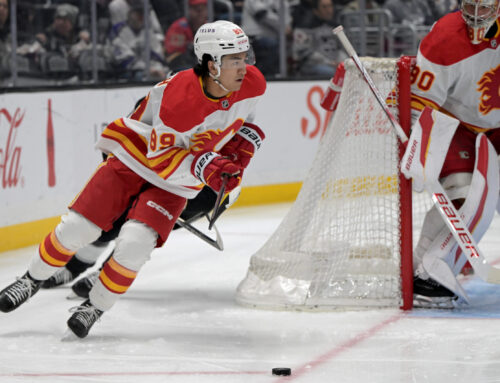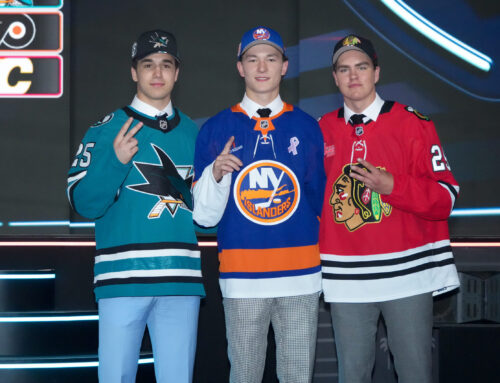Welcome back to The Journey, where we follow hockey prospects and their paths to the NHL, providing fantasy predictions and analysis along the way.
In a recent Goldilocks and the Three Skaters article, Rick Roos outlined a series of very realistic concerns about Anton Lundell's ability to replicate his 56-point pace rookie campaign moving forward. Those concerns include the relative lack of historical precedents for what the 20-year-old Finn accomplished last year, the Panthers likely taking a step back in team scoring after a historic offensive season, and Lundell possibly not having a secure place in the top six.
He also forwarded Jordan Staal, who has never been a prolific producer despite his multi-cat prowess and significant real-life impact, as a potential comparable for Lundell. Poolies do not want Lundell to max out at a 60-point ceiling like Staal did, so the possibility that he could get pigeonholed as a third-line center with little power-play time is very concerning.
Rick's excellent, devastating article—and my resulting feelings of dismay about Lundell, who I've been high on—got me thinking about this perception in fantasy about players who are "too complete." It can often feel like a kiss of death in fantasy.
Sure, Jamie Drysdale can run a power play, for instance, but he might lose power-play time to Olen Zellweger in a couple years because he is too all-around talented. Yes, Shane Wright can score, but he is also responsible defensively and will probably get sent out against the toughest competition in the most critical situations—in particular, defensive zone draws and playing shorthanded. Ditto for Alex Pietrangelo, Ivan Provorov, Bo Horvat….the list goes on and on.
True, it is difficult to score when you're starting out 200 feet from your own goal or playing with one fewer teammate. But does the "two-way, complete player" label always have to be a death knell for fantasy value? While it can be in many cases, there is a small group of forwards who represent a different potential outcome than Staal for Lundell and other young complete players (Wright, Matty Beniers, Fyodor Svechkov)—a future where he follows in the footsteps of teammate Aleksander Barkov to become dominant on both offence and defence, keeping his value in fantasy high and secure.

Other members of this group include the who's who of recent Selke award winners and nominees: Sean Couturier, Elias Lindholm, Anze Kopitar, and of course the incomparable Patrice Bergeron. To better situate Lundell in relation to these players, here is the rookie season data for those members of that group who entered the league after 2010 when the NHL began tracking advanced stats.
| Point Pace | TOI | Corsi For | FW % | IPP | PP IPP | OZ% | SH% | PP% | |
| Lundell | 56 | 15:44 | 55 | 45 | 58 | 57 | 48 | 45 | 13 |
| Barkov | 36 | 17:06 | 52 | 49 | 57 | 67 | 52 | 3 | 46 |
| Couturier | 30 | 14:08 | 50 | 47 | 65 | 33 | 40 | 43 | 7 |
| Lindholm | 30 | 14:32 | 50 | 46 | 54 | 50 | 63 | 1 | 47 |
Obviously, Lundell's point pace leads this group by a mile despite receiving very little power-play time. As Rick pointed out, almost no rookie in league history has produced such a strong point total while receiving such minimal ice time and opportunity. But while his high point pace and CF% are connected to the strength of his team, they are also still significant individual achievements.
Lundell had a comparable face-off winning percentage and IPP to the others, both of which bode well for his future success as a two-way centre who can score. While a 55-65 IPP is still below the mark of 70 that stands as a rough benchmark for fantasy success, it is clearly not a bad range for a rookie. After all, Barkov, Couturier, and Lindholm have all gone on to become top scorers in the league. And though Lundell's power-play time was limited, his solid PP IPP relative to this group suggests that he is doing just fine and would thrive if given more time with the man advantage.
To help project what kind of numbers Lundell might be capable of by the time he hits his Breakout Threshold, here are some stats from the seasons when each of the players in the group listed above hit their respective BTs.
| BT Year | GP | Point Pace | Corsi For | FW% | IPP | PP IPP | OZ% | SH% | PP% | |
| Barkov | 2016-17 | 191 | 69 | 55 | 47 | 74 | 70 | 55 | 25 | 51 |
| Couturier | 2017-18 | 416 | 76 | 53 | 53 | 54 | 34 | 43 | 45 | 61 |
| Lindholm | 2018-19 | 374 | 79 | 55 | 54 | 62 | 68 | 56 | 45 | 59 |
| J. Staal | 2013-14 | 398 | 40 | 54 | 54 | 66 | 53 | 50 | 35 | 40 |
| Bergeron | 2011-12 | 227 | 65 | 59 | 59 | 70 | 70 | 48 | 35 | 50 |
| Kopitar | 2012-13 | 403 | 73 | 61 | 53 | 68 | 70 | 56 | 28 | 54 |
Except for Staal, the other five players listed here were all seeing significant PP time and putting up 65+ points by the time they hit their Breakout Thresholds—even though Couturier and Lindholm, as average-sized players, inexplicably took twice as long as predicted to reach theirs. Those five players managed that high-end production while seeing a fairly even mix of offensive and defensive zone face-offs and taking the ice for at least 25% of their team's shorthanded time.
All had strong play-driving numbers (CF of 53+) and were above-average in the face-off dot—except Barkov, who pushed north of 50 the following season and stayed there. Staal and Couturier stick out primarily due to their lack of PP proficiency. Both were well below the 70-range of their peers. Inconsistency with the man advantage has actually plagued both players throughout their careers: Couturier has an average PP IPP of 56% and Staal has a 49%. But while Couturier has found ways to produce at even strength without posting huge PP totals, Staal's lack of consistent PP points has played a significant role in him never posting more than 50 points in a season.
That brings us to linemates and opportunity. Part of the reason for Rick's Staal comparison was that Lundell may well be blocked at centre behind Barkov and Reinhart or Bennett—similarly to how Staal was blocked by Crosby and Malkin. The fear is that, like Staal, Lundell could be relegated indefinitely to the third line C role and have to play outside the top six, likely capping his production in the 50s.
First, it's important to note that the situation Lundell finds himself in two years from now when he hits his 200-game BT is arguably more important than the specific linemates and deployment he'll see in 2022-23. By that point, Patric Hornqvist has likely moved on and Sam Reinhart and Anthony Duclair, both locks in Florida's top six at the moment, will be UFAs.
Further, Reinhart and Bennett, Lundell's probable competition for the 2C role, are not generational players like Crosby and Malkin—neither is Barkov, even though he is an elite player. In that way, there is a lot more flexibility in Florida's top six than Staal was facing in Pittsburgh. Both Reinhart (48.5%) and Bennett (46.8%) outperformed Lundell (44.7%) at face-offs in 2021-22 but both have played the wing a lot in their careers and could slide over again if Lundell can increase his proficiency—thereby keeping Lundell in the top six.
Second, although it's hard to say how lines end up shaking out, it certainly looks like the Cats brought in Colin White from the Senators to occupy that third-line C role. White is decent at face-offs (48% win rate last year) and makes much more sense on a third line than in the top six like he was forced into with Ottawa. If White does become the primary 3C, that increases Lundell's odds of sticking in the top six, even if he slides to the wing at times.
While Lundell's unprecedented rookie season makes him a bit of a fantasy unicorn, that does not necessarily mean he is destined to become another Jordan Staal. If he can continue gaining strength at the face-off dot, driving play, and involving himself in scoring, particularly on the power play—all of which are conceivable over the next couple years—Lundell could very well be on track to join this special group of elite two-way centres who play in all situations, take key face-offs, and consistently threaten for 70+ points a year. For reference, Dobber has his upside at 88 points in the Fantasy Guide.
Thanks for reading! Follow me on Twitter @beegare for more prospect content and fantasy hockey analysis.
One Comment
Leave A Comment
You must be logged in to post a comment.




 FLA
FLA CHI
CHI NYR
NYR PIT
PIT L.A
L.A COL
COL CBJ
CBJ ANA
ANA MTL
MTL TOR
TOR WPG
WPG SEA
SEA S.J
S.J BOS
BOS VAN
VAN

I always think of this type of player and whether they are gong to Ryan Kesler, and explode with opportunity after doing the hard lifting, like coors did several years later. it was about opportunity as you get to at the end. I play in a format wit shp, fw, hits avs blocks so a j staal, even after 50 points can be a foundational piece, I’ve been to 7 finals with him, after trading Kesler for him in 2014 or so. Guy like Lundell is a hard target for me as some owners start to question whether he willKesler, ever.